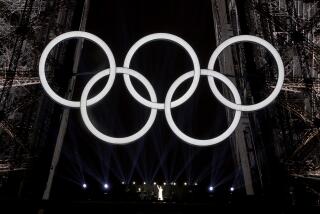UP CLOSE AND PERSONAL, A ROSY VIEW
It is a thought, lodged somewhere between amusing and awe-inspiring, that at 9 o’clock on New Year’s morning the largest concentration of piccolo players in the known world is in Pasadena, Calif.
Having chided the audio-visual coverage of the Rose Parade in a couple of previous Januaries, I grasped with pleasure the chance to see what the event feels like live, from a reserved seat on Orange Grove Avenue.
For the irredeemably hardhearted, it is possible to dismiss the Tournament of Roses Parade as middle-class American taste, sentimentality and optimism pushed to extremes of gaudy display and needless cost.
It is also possible to dismiss the World Series as a profit-making enterprise, the Olympics as muscle diplomacy and the Harvard-Yale game as a benefit to pay for the stadiums. It’s all in the beholding.
And as you are there and watching, the Rose Parade is so astonishingly good-natured as to be beyond sour criticism. It may invite the lively parody of the Doo Dah Parade, but only in the sense that true parody is a form of homage to a style so strong and individual that it can in fact be recognized in parody.
In many ways the Rose Parade is indeed a parading of traditional American values. It is a model of planning, efficiency and organization (it stuns the mind to guess how and where all those piccolo players are housed, let alone the snare drummers, let alone the flag twirlers).
The million who attend must constitute the most orderly crowd ever assembled, cheerful and push-free, pleased to be in the sunshine, it may well be. Our part of the bleachers cheered all morning for the two young men--in the ice-cream-white suits and the red ties that are the uniform of the Tournament of Roses staff--who were the emergency cleanup detail in our block, dashing out with shovel and push broom in the intervals between departing horses and arriving bandsmen. Volunteerism has to start somewhere.
The parade starts when it says it will start, not later, or so it was this year, and it ends promptly, having I daresay calculated over decades of experience just what the traffic and spine will bear. One more float, one more band and I’d have left by gurney.
Like the displays at the Pageant of the Masters in Laguna, the floral floats are a special form of art, to say the least, but they are not less terrifying than more traditional forms in their nerve-wracking need to keep topping themselves every year.
They are also, like other art forms, susceptible to criticism in their own terms and, watching five dozen floats roll by, you don’t lose much time learning to welcome the wit over the pretention, the ingenuity over the mere elaboration, the soft sell over the hard sell.
Although it took no prize, the Transamerica-Occidental float, “East of the Sun, West of the Moon,” bearing two former Rose Queens, seemed uncommonly graceful. The La Canada Flintridge entry, “Road to Stardom,” did take a prize, the Founder’s Trophy for best self-built float, and it was a very funny, animated Mad Comics vision of Hollywood or Bust. The use of the flowers is always ingenious, but the means have long since become less important than the ends.
It occurs to me that television, time-pressed to hand out as chitchat the formal and florid descriptions of the floats and riders, gives a slightly more bloodless impression of the parade than you get at curbside. The amazing thing is that, the million spectators and the zillion hours of flower-fastening notwithstanding, the Rose Parade still retains a genuine small-city, Middle-American, “Hey, there’s Uncle Fred” feeling--a spontaneity that survives the size.
I don’t know quite what to make of the 22 bands. They get larger and larger and larger--28 tubas I counted in the Big Ten Conference Band--and dressier and dressier. With those numbers, it’s a miracle that the front row and the back row are on the same beat. I suspect the musicianship is at a high level; the Midland, Tex., Bulldog Band coped well with John Williams’ tongue-testing Olympic fanfare and theme.
Still, I had the treasonable feeling that some optimum size had been reached and surpassed and that the giant bands look better than they sound. They thunder and lumber, but I could have used more high-cadence pizazz.
I also hadn’t realized how popular the gonfalon drill teams had become. But the banners, waving on sticks, while they produce nice patterns, I find a very limited art form, like close-order drill. But maybe my objection is more subjective. The automaton-like precision that spells perfection in the flag drills I found vaguely depressing. It looked like a voluntary surrender of more individuality than I would want to surrender. I tried to march in step, but I liked playing my own notes.
Like the parade, it’s a matter of taste, and you have to keep an open mind.
More to Read
The biggest entertainment stories
Get our big stories about Hollywood, film, television, music, arts, culture and more right in your inbox as soon as they publish.
You may occasionally receive promotional content from the Los Angeles Times.










